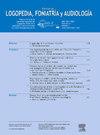La voz en la atrofia muscular espinal. Una revisión no sistemática
Q3 Nursing
引用次数: 0
Abstract
Spinal muscular atrophy is a recessive autosomal neuromuscular disease that causes degeneration of alpha motor neurons in the spinal cord and dysfunction of the neuromuscular junction, which causes a progressive muscular weakness and hypotonia affecting the limbs, axial musculature, and respiratory musculature. It can also concur with bulbar dysfunction, which affects the glossopharyngeal, vagus, accessory and hypoglossal nerves. In such cases, it can cause dysphagia, dysarthria, flaccid paralysis, atrophy and fasciculation of the muscles innervated by said cranial nerves. Regarding vocal function, there are few works that describe it thoroughly. The goal of this work is to put forward a state of the art about what is known about voice in SMA. A non-systematic review of works mentioning voice in SMA has been carried out against the databases of PubMed, ScienceDirect and Google Scholar. The features of voice in SMA found in the articles are: vocal weakness, low intensity, velar and pharyngeal hypotonia, nasality, wet voice, and bilateral cordal palsy. It is necessary to carry over a more detailed assessment of vocal conditions in SMA patients in order to complete current knowledge about the natural history of the disease, and in order to objectify the progress of said patients in clinical trials.
声音在脊髓肌肉萎缩。不系统的审查
脊髓性肌萎缩症是一种隐性常染色体神经肌肉疾病,引起脊髓α运动神经元变性和神经肌肉连接处功能障碍,导致进行性肌肉无力和张力低下,影响四肢、轴向肌肉组织和呼吸肌肉组织。它也可合并球功能障碍,影响舌咽神经、迷走神经、副神经和舌下神经。在这种情况下,它会导致吞咽困难,构音障碍,弛缓性麻痹,萎缩和由颅神经支配的肌肉的束状。关于声乐功能,很少有著作对其进行深入的描述。这项工作的目标是提出关于SMA中语音的已知技术的最新状态。针对PubMed、ScienceDirect和b谷歌Scholar的数据库,对提到SMA语音的作品进行了非系统综述。文章中发现的SMA的语音特征为:声音无力、低强度、膈肌和咽部张力低下、鼻音、湿音、双侧声带麻痹。有必要对SMA患者的声带状况进行更详细的评估,以完成目前对该疾病自然史的了解,并使所述患者在临床试验中的进展客观化。
本文章由计算机程序翻译,如有差异,请以英文原文为准。
求助全文
约1分钟内获得全文
求助全文
来源期刊

Revista de Logopedia, Foniatria y Audiologia
Nursing-LPN and LVN
CiteScore
1.10
自引率
0.00%
发文量
28
 求助内容:
求助内容: 应助结果提醒方式:
应助结果提醒方式:


